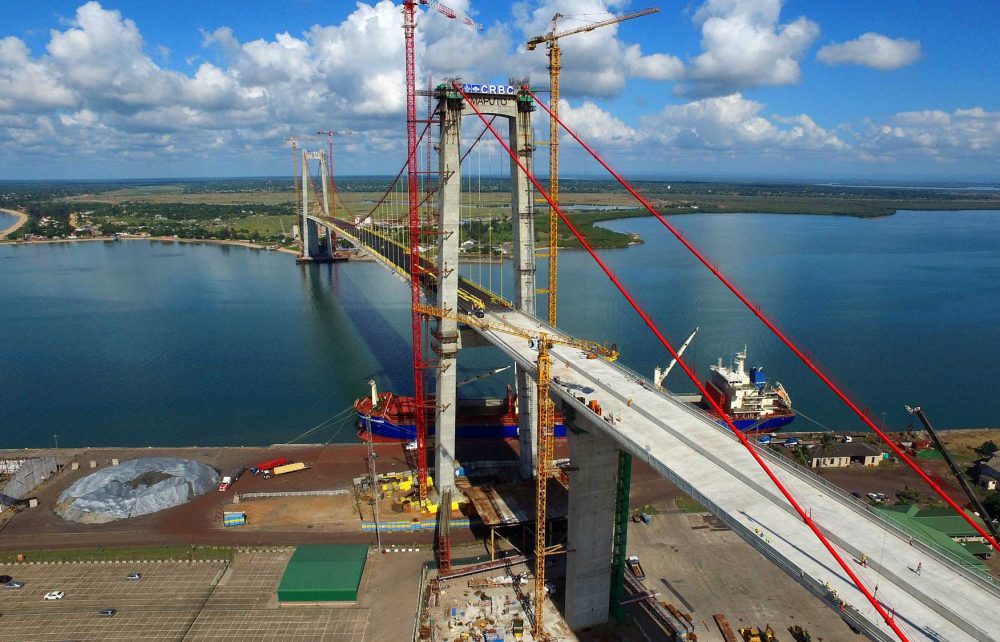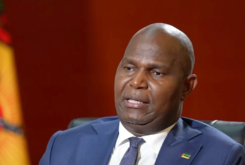The highly anticipated 2.7 km Maputo-Catembe Bridge that will link the Maputo Bay shores will be delayed for a second time this year. The bridge is China’s largest construction project in Mozambique and one that government officials are eagerly awaiting.
Planned in 2012, the Maputo-Catembe Bridge, the largest suspension bridge in all of Africa, costs US$ 725 million. 95% of it has been financed by a Chinese credit line provided by the China Export-Import Bank (Ex-Im). The bridge will have four tolls in order to fund this loan to be paid over a period of 20 years, with a five-year grace period and an interest rate of 4%. The Mozambican State Budget covers the remaining 5% of the costs.
The project includes 200 kilometers of roads and five smaller bridges between Maputo and Ponta do Ouro, in the south of the country, close to the South African border.
Reasons for delays in completing the bridge include the relocation and rehousing of around 900 families in the area, misunderstandings between the municipalities of Maputo, and small market owners. Originally scheduled to open on 25 June, Mozambican Independence Day, it may now only open later this year.
The construction of the bridge is being managed by the Ministry of Public Works, Housing and Water Resources, Empresa Desenvolvimento Maputo-Sul (EDMS), headed by its president Silva Magaia, and the construction company, China Road and Bridge Corporation (CRBC).
Due to the lack of EDMS funds, compensation payments for the relocated inhabitants in the area and construction of new housing infrastructure have been funded by CRBC. Previously, CRBC also advanced payment for rehousing and construction of basic infrastructures for the Maputo circular road project, amounting to a total of US$100 million. The company is not considering financing any more up-front payments.
The original plan was that EDMS would pay CRBC for the construction of the bridge with funds received from developing the surrounding real estate (housing and offices in Matola area), which would directly service the bridge. Despite initial interest in sub-concessions of land and developing the area, the project has not progressed any further.
To move forward with developing the southern bank area, the government must grant land licenses to public companies. According to sources, disputes over licenses have arisen within those who hold political power.
Given the continued slowdown of the economy, linked to the financial constraints of the State, the prospects of selling land in Maputo’s southern area are now substantially lower than at the beginning of the project.
The Olympic Village II (Zimpeto) project initially put forward in early 2016 during the debt crisis financed by Macao-based construction company Charlestrong has not progressed any further and now sits empty.
Currently, the EDMS, government, and CRBC are adjusting toll fees based on an estimate of 5,000 vehicles passing through the bridge per day, though this may decrease to 4,000 vehicles per day given the current economic slowdown.
Many doubt that the toll fees will be able to support even 30% of the construction work. Increasing the toll fees may defer drivers from using the bridge altogether. According to original estimates, repayment of the investment could reach up to 75 years. Taking into account the forecasted roll revenues, the government estimates the value of a 30-year infrastructure concession to be US$ 1 billion.
Given the Mozambican government’s current financial situation – defaulting on bond loans and bilateral debt, the remuneration of the initial credit granted for the construction of the bridge is now deemed unfeasible without financial restructuring.
The bridge will also have substantial associated maintenance costs and services that will have to be provided by private companies, due to the state’s lack of experience in technical capacity and infrastructure.
In addition to the Maputo-Catembe Bridge, there are large projects that still have to be paid by the state, such as the Maputo Ring Road project (US$ 315 million), Nacala airport (US$ 215 million), Pemba logistics base or the bridge over the Zambezi river (US$ 76 million).
The most recent forecasts by the International Monetary Fund (IMF) indicate that Mozambique’s public debt will reach 130% of the total GDP by 2022, compared to 110% in 2018 and 116% in 2019. Mozambique is one of six sub-Saharan African countries, which the IMF has identified as having an unsustainable debt compared to the size of its economy.
In negotiations with the CRBC, the Mozambican government is mainly interested in finding a solution that does not result in a significant increase in debt, given that the cost of infrastructure represents around 7% of GDP. Their Chinese counterpart is also interested in adopting new financing methods. Among these, increased corporate investment in self-sustaining infrastructures by large public or private conglomerates, under a public-private partnership or concession.




